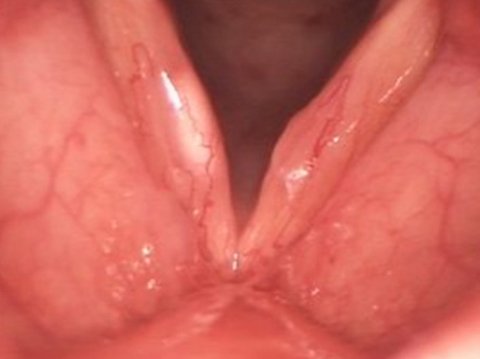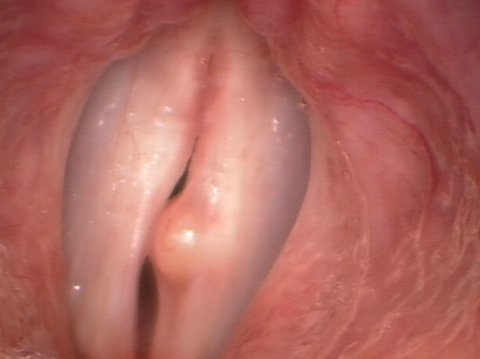What is a vocal cord or vocal fold cyst?
A vocal cord cyst predominantly manifests unilaterally as a spherical to oval structure characteristically in the mid-third of the vocal fold. The cyst is not localized on the surface of the vocal fold, but deeply embedded in the tissue of Reinke´s space.
Vocal fold cysts usually have a yellow to white appearance, can be small in shape, but sometimes grow to a significant size and cause severe deformation of the vocal fold body.
The most common type is the mucous retention cyst. These cysts are surrounded by a sac, which is frequently interlaced with abnormally prominent blood vessels. The inside of the cyst is filled with yellow white secretion.
The stroboscopic examination reveals impaired vibration of the vocal fold mucosa.
Smaller-sized vocal fold cyst


How does a vocal cord cyst develop?
There are two different types of cysts that grow from inside the vocal cords:
- Mucous retention cysts
- Epidermoid cysts
The pathogenesis of vocal cord cysts is not clearly explained. It is suspected that mucous retention cysts develop from inflammatory processes or that voice overuse causes blockage of one or more of the glandular ducts. The secretion produced by the glands can no longer drain off and is retained inside the gland. With time, mucus that keeps being produced turns into a cyst that then grows inside the vocal fold.
The other type is called epidermoid cyst. These are presumed to be a form of congenital lesions. Epidermoid cysts of the vocal fold are usually much smaller and detected as an incidental unilateral finding in chronically hoarse patients. In rare cases, these cysts can also occur on both sides, i.e. bilaterally.
Medium-sized vocal cord cyst


What symptoms are caused by a vocal fold cyst?
The typical sign of vocal fold cysts is a more or less pronounced level of hoarseness. The swelling in the mid-third of the vocal folds usually significantly impedes vocal fold vibrations, thereby causing the voice to sound rough and hoarse.
The degree of hoarseness increases proportionately with the increasing size of the cyst. It can also happen that a cyst will burst; after some of the mucosal secretion empties out, the cyst sac closes back up.
As a result, the initially severe hoarseness suddenly normalizes, namely in the moment the cyst bursts. After a while, however, the hoarseness returns; this is consistent with the cystic sac filling up again with secreted mucus.
In rare cases, vocal cord cysts can grow so large that they restrict breathing as well.

What treatment options are available for vocal cysts?
- Voice surgery
Treatments that have no effect on the symptomatology:
- Pharmacotherapy
- Inhalation
- Voice therapy
Vocal fold cysts belong to those disorders that respond exclusively to phonosurgical treatment. Because they are localized deep in the vocal fold body, inhalation therapy or drugs are not helpful in treating vocal cysts.
Voice therapy programs can only help in the early stages in that they allow patients to compensate somewhat for their voice disorder.
The basic principle is that vocal cord cysts can only be eradicated by voice surgery.
The phonosurgical procedure to treat vocal cord cysts is explained in detail in the section Voice Surgery for Vocal Cord Cysts..
Example: Phonosurgical management of a vocal cord cyst
Vocal fold cyst before surgery
Vocal fold cyst after surgery

Truths and Myths About Vocal Cord Cysts
A vocal cord cyst is predominantly a solitary diseased structure on one vocal fold. The suspicion frequently expressed by patients that there might be an interconnection between vocal cord cysts and cystic diseases of other organs like, e.g. kidney or liver cysts, has not been proven to date.
Similarly, patients with one vocal cord cyst are not necessarily expected to developed additional intracordal cysts of their vocal folds or in any other part of their body.

Case report: Vocal fold cyst
A 52-year-old movie director had been noticing increasing hoarseness for a period of around eight months. He reported that his voice was initially mildly veiled and hoarse, but over the course of months, his voice developed a significant hoarseness and became deeper in pitch. Speaking was difficult; making loud calls on the set had become increasingly strenuous. His voice tired much faster than in recent times.
The patient reported smoking 5-10 cigarettes a day. Moreover, he noted, before the hoarseness started, that he had suffered a bout of severe laryngitis. Due to demands of the job, he continued to overuse his voice despite the laryngitis. Afterwards, his symptoms began to appear.
The videostroboscopic examination showed a typical pronounced vocal fold cyst in the mid-third of the left vocal fold that protruded medially into the vocal fold margin. Compared to the right side, the vocal fold vibrations were considerably restricted and vocal fold closure was no longer possible because the cyst posed a significant impediment, blocking vocal fold closure.
The patient's voice quality was hoarse, rough and his average speaking pitch markedly deeper than normal. His singing voice had disappeared entirely.
The patient was advised to undergo a phonosurgical intervention. This would involve the operative method of plastic reconstruction. After successful surgery and a two-week phase of vocal rest, the afflicted vocal fold exhibited a smooth vocal fold margin that showed only minimal subsidence compared to the contralateral side. The vibrations were mostly equilateral. The vocal folds were able to close completely. The patient’s voice quality was strong and clear and he described his average speaking pitch as normal. He perceived his voice to be like it was before the hoarseness set in.
After a year, the patient presented for a follow-up examination. No recurrence of any cyst was found on the vocal cords. The slight subsidence to the vocal fold margin formerly afflicted by the cyst had meanwhile normalized. The vibratory patterns were now completely equilateral.




